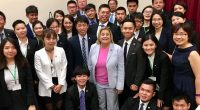ALTERING THE STATUS QUO IN THE TAIWAN STRAIT
The Merriam-Webster online dictionary defines “status quo” as “the existing state of affairs.”
US Secretary of Defense James Mattis knows what it means.
The former general said this past June that “we oppose all unilateral efforts to alter the ‘status quo’ [in the Taiwan Strait] and will continue to insist any resolution of differences accord with the wishes of the people on both sides of the Taiwan Strait.”
China has been changing the ‘status quo’ in the Taiwan Strait over the past decades and Taiwan has not.
How did China change the status quo? A handful of examples:
It enacted its “Anti-Secession” Law in 2005.
When Chinese President Xi Jinping came to power in 2012, he promulgated the “Chinese Dream.” Xi identified the annexation of Taiwan as a major component of this, saying that any attempts at “separatism” would face “the punishment of history.” He hinted that China must take control of Taiwan by 2050.
China has conducted numerous long-range military live-fire drills in the Taiwan Strait; sent bombers flying over major waterways around Taiwan; dispatched warships that trespassed into Taiwan’s territorial waters; and in January 2018 unilaterally launched a new aviation corridor over the Taiwan Strait.
On the diplomatic front, China this year poached two of Taiwan’s diplomatic allies — the Dominican Republic and Burkina Faso within in month.
On May 30, former American Institute in Taiwan chairman Richard Bush said that he would like to see “a very senior official in the United States […]say to its counterpart in China: ‘We are not trying to change the status quo. Taiwan is not trying to change the status quo. You are trying to change the status quo.’”
Bush is of course right. The time is now for US President Donald Trump, US Secretary of State Mike Pompeo, Mattis and other US officials to read the Chinese the riot act when it comes to the “status quo” in the Taiwan Strait.
The time is now for the US to speak out without inhibitions!
中國正在改變台海現狀
韋氏線上詞典將「現狀」 (status quo) 定義為「現正存在的狀態」。
美國國防部長馬提斯(James Mattis)很清楚 「現狀」 的意涵。馬提斯上將在今年6月曾指出:「我們反對任何片面改變(台海)現狀的舉動,並且會持續堅持任何解決分歧的方式必須符合台灣海峽兩岸人民的意願。」
過去數十年來大幅改變海峽兩岸現狀的是中國,不是台灣。
中國如何改變現狀? 以下有數個例子:
中國於2005年通過《反分裂國家法》。
習近平於2012年掌權後發表了「中國夢」。他指出併吞台灣是中國夢的重要環節,並稱「分裂」祖國的行徑將受到「歷史的懲罰」。習近平的種種言論暗示了中共必在2050年之前併吞控制台灣。
近來中國的軍事挑釁也愈來愈明目張膽。不僅在台灣海峽進行多次長程實彈射擊軍事演習,頻以軍機及航艦繞台方式進行遠海長訓;更逕行在今年1月開通涵蓋跨半個台灣海峽的M503航線。這些例子僅是九牛一毛。
AIT前理事主席卜睿哲於5月30日在布魯金斯學會的研討會中表示,他希望川普政府高層的官員,可能是總統、國務卿或是國防部長,能向中國相應官員表示美國並沒有試著改變現狀,台灣也沒有試圖改變現狀,但中方卻一再企圖改變現狀。
卜睿哲言之有理。美國總統川普、國務卿龐皮歐(Mike Pompeo)、國防部長馬提斯應嚴厲斥責,不應再縱容中國顛覆台海現狀的種種挑釁行為。
現在是美國放下任何顧忌,公開譴責中國的時機。


